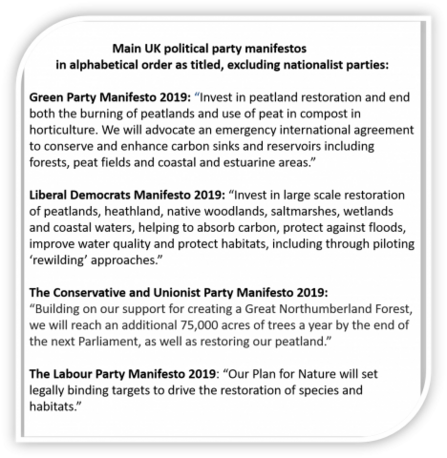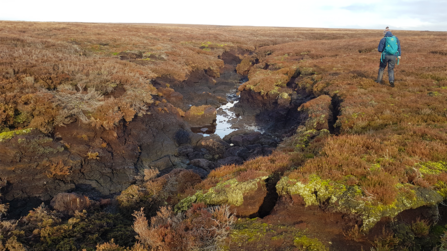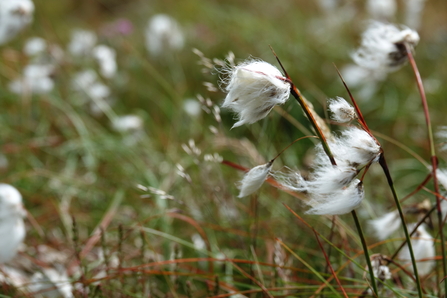2019 has seen all four devolved governments across the UK declare a climate emergency which will require urgent action and a dramatic reduction in the UK’s greenhouse gas (GHG) emissions to reach a target of Net Zero by 2050 (2045 in Scotland). GHG emissions from UK peatlands are estimated to contribute around 4% of the UK's total annual greenhouse gas (GHG) emissions and therefore represent a significant opportunity to reduce emissions through restoration activity. The four main UK political parties, excluding nationalist parties, register the importance of restoring natural habitats in their Manifestos (see extracts below) with three out of the four specifically featuring “peatland restoration” promises.
Peatlands and the climate emergency

Climate emergency declared - main party manifestos 2019.
Through the Commission of Inquiry on Peatlands Update: ‘State of UK peatlands’ report it is clear that the scale of degradation is still significant and that current levels of restoration activity, policy and funding support all need to be escalated to meet the UK targets. The Office for National Statistics (ONS) report on peatland natural capital suggests that the costs of restoring 100% of UK peatlands could be significant at between £8 billion and £22 billion. The Committee on Climate Change’s Net Zero report recommends that a minimum of 55% of degraded peatlands would need to be restored to healthy, functioning ecosystems to meet the 2050 targets: ONS estimates the benefits of achieving this Net Zero target for peatland restoration would bring benefits in the order of £45 billion to £51 billion over the next 100 years.

Eroding gully in North Pennies. Credit North Pennines National Landscape
As a result of these targets and recommendations we are seeing an increase in peatland policy attention with a strong framing around carbon and climate change in tandem with an upwelling in public appreciation for peatlands and the co-benefits of restoration. We are, at the same time, facing an ecological crisis and we want to ensure that the biodiversity and wildlife message is not lost. We must all seek to take adaptable and sustainable actions: not only seeking to maximise carbon storage and avoidable carbon losses but to value the suite of benefits that healthy peatlands provide in both our upland and lowland landscapes.
With this sharpened focus, we need to ensure that peatlands are included in all aspects of the climate debate. Strong communications, robust science and sound policy are required to engage people with the peatland story. As a Programme, and as a peatland community, we need to continue to integrate peatlands into the wider agenda as a mainstream and accepted climate change solution.

Common cottongrass (Eriophorum angustifolium). Credit Emma Hinchliffe
